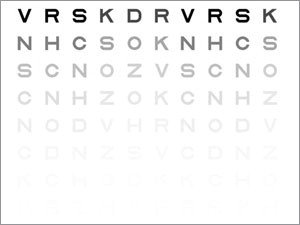A mind of its own

Basic areas of the brain's visual system show evidence of learning
One by one, images of ordinary objects flashed on the computer screen. Each stayed up for only about 0.015 second.
One psychologist watching the screen couldn't even tell that any images were coming up, let alone name the objects. But a second rattled off their names without a hitch.
The second, University of Minnesota psychology professor Stephen Engel, had a powerful advantage: He had trained himself to detect images that a "naïve" eye never could.
And now he has discovered one of the brain's secrets for pulling off similar feats: With practice, areas of the brain that perform some of the earliest processing of visual signals can rewire themselves to amplify their responses to images. That is, they can "learn" to respond more strongly. This is a step in learning to see images we couldn't detect before.
"It's like a hearing aid," Engel explains. "With practice, people are building their own amplifier in a region where the early stages of visual processing occur. That 'turns up the volume' on faint images so they can see them better."
The work may someday help efforts to train people to recognize subtle patterns faster or more reliably.
"There are lots of activities that require visual learning," says Engel. "Radiologists reading X rays and security people looking at bomb scanners, for example. What we're learning here may tell us something about how that kind of expertise works, and once you know that, you may be able to use it to improve performance."
The information chain
When visual signals leave the eyes, they pass through the midbrain and then to the visual cortex, the part of the cerebrum that processes visual information and allows us to see.
The signals' first stop is an area at the back of the brain called the primary visual cortex, or V1. From there information moves to some 20-30 other visual areas arranged in a rough hierarchy; among the last to receive the signals are higher areas of the cortex associated with conscious awareness.
There was already some evidence for learning in the V1 area, says Engel. And V1 does receive feedback from higher brain areas like those associated with consciousness. But there was a question as to whether the earliest signals produced in V1--which are independent of feedback--could be strengthened when subjects learn to recognize faint visual patterns.
A grating experiment
To find out, he and his team trained 14 subjects with a pattern of progressively fainter lines on a computer screen. Over 30 days, their ability to detect faint lines improved by about 30 percent.
Working with biomedical engineering professor Bin He, the team measured EEG responses arising from V1 neurons when the subjects were shown the line patterns before and after the training period. The neurons gave significantly stronger responses after the training.
But the speed of the responses—only 50-70 milliseconds after the lines were presented—implied that the V1 neurons were acting without "coaching" from higher areas.
"We've ruled out feedback from conscious areas because that would be slow," Engel explains.
How the V1 area learned to strengthen its response to the faint lines is still unknown. Feedback from higher areas could influence the learning process, Engel notes, but it plays no part in the responses themselves.
"[Learning] could be the result of connections from other neurons or something about the neurons themselves, or more neurons responding to the cues over time," Engel says.
The function of V1 neurons was thought to be fixed because they distribute information to the rest of the brain, he says. Instead, "we've shown that the results of learning can appear in [V1] and the expression of those results--that is, the amplified signals--does not require input from higher cortical areas." V1, then, is another site of learning, like a mind within a mind.
One possible medical application may be in amblyopia, a brain disorder in which one eye produces a much weaker signal in the brain than the other eye.
"We'd like to understand how to strengthen the response of neurons to the bad eye in the visual cortex," Engel says. "The kind of learning we studied is an example of neurons strengthening their response. So we may be able to apply what we've learned here to that problem."
The work is published in the November 10, 2010, issue of the Journal of Neuroscience.
